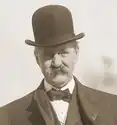| ||||||||||||||||||||||||||||||||||||||||||||||||||||||||||||||||||||||||||||||||||||||
987 delegates to the 1916 Republican National Convention 494 (majority) votes needed to win | ||||||||||||||||||||||||||||||||||||||||||||||||||||||||||||||||||||||||||||||||||||||
|---|---|---|---|---|---|---|---|---|---|---|---|---|---|---|---|---|---|---|---|---|---|---|---|---|---|---|---|---|---|---|---|---|---|---|---|---|---|---|---|---|---|---|---|---|---|---|---|---|---|---|---|---|---|---|---|---|---|---|---|---|---|---|---|---|---|---|---|---|---|---|---|---|---|---|---|---|---|---|---|---|---|---|---|---|---|---|
| ||||||||||||||||||||||||||||||||||||||||||||||||||||||||||||||||||||||||||||||||||||||


Hughes Weeks Root Cummins Burton Fairbanks Roosevelt La Follette Various[lower-alpha 4][lower-alpha 5] | ||||||||||||||||||||||||||||||||||||||||||||||||||||||||||||||||||||||||||||||||||||||
| ||||||||||||||||||||||||||||||||||||||||||||||||||||||||||||||||||||||||||||||||||||||
From March 7 to June 6, through a series of primaries and caucuses, voters of the Republican Party elected delegates to the 1916 Republican National Convention, held June 7 to June 10, 1916, in Chicago, Illinois to choose the party's nominee for President of the United States. The delegate election process was inconclusive, with a small plurality supporting Associate Justice of the Supreme Court Charles Evans Hughes. Hughes eventually secured the nomination on the third ballot.[1]
Several more conservative or progressive candidates received a large share of elected delegates. Conservatives split between Senator John W. Weeks, Senator Elihu Root, and former Vice President Charles W. Fairbanks. Progressives rallied behind Senator Albert Cummins, who dominated the primaries, Senator Robert M. La Follette, and former President Theodore Roosevelt, who returned to the party after fatally splitting it in the 1912 election. Neither faction consolidated behind any one candidate, and the moderate Hughes, acceptable to all parties, prevailed.
Background
1912 presidential election
The 1912 presidential election was an epochal disaster for the Republican Party, which had won eleven of the previous thirteen elections, a period of dominance only interrupted by the two non-consecutive terms of Grover Cleveland and unequaled before or since in the history of the United States. Former President Theodore Roosevelt challenged William Howard Taft for the Republican nomination, dissatisfied with his successor's policies and encouraged by a groundswell of popular support. Despite this support, Roosevelt was unable to crack Taft's hold over the convention and caucus systems by which most delegates were selected and, declaring the nomination illegitimate, broke off to form the Progressive Party. With the Republicans split between Roosevelt and Taft, Democratic nominee Woodrow Wilson easily won a landslide election, albeit with a plurality of the vote.
1914 midterms
The 1914 midterm elections were a disappointment for the Republicans; the Democratic Party retained control of both chambers for the first time since the American Civil War. Republicans were partly damaged by the passage of the 17th Amendment to the United States Constitution, which required the direct popular election of United States Senators for the first time (despite opposition from many Republicans), and the continued presence of the Progressive Party.
The Democratic majority in the Senate was expanded to 56 seats, in many cases by a plurality, mirroring President Wilson's. In California, Colorado, Indiana, and Oregon, the Progressive vote more than accounted for the margin of Democratic victory.
The Progressive Party itself fared far worse. Only California, where Republican governor Hiram Johnson was re-elected on the Progressive ticket, presented any success whatsoever. The party's national vote was cut in half without Roosevelt to lead its ticket.[2]
World War I
In July 1914, war broke out in Europe. At the start, Americans remained aloof from the conflict, even as naval warfare interrupted transatlantic shipping. News of German atrocities in Belgium did elicit support for the Allied side but did not alter the general national stance of neutrality.
Within the Republican Party, views of the war were mixed:
- Anglophiles, especially Eastern elites like Roosevelt and Senator Elihu Root, vigorously backed the Preparedness Movement and called for unambiguous support for Britain.[3]
- Isolationists, especially Midwesterners and Westerners like Senators Robert M. La Follette and Albert Cummins, saw the war as irrelevant or hazardous to American interests.
- Internationalists such as A. Lawrence Lowell and Taft joined President Wilson in favoring the establishment of American-led institutions for arbitration to end the war.[4]
After the sinking of the RMS Lusitania in May 1915, American public opinion turned decisively in favor of the Allied forces. Wilson's tepid response, which did not mention the Lusitania by name or threaten any retaliatory action, enraged Republican interventionists. Nevertheless, the mood of the country was "overwhelming antiwar," and Wilson won praise for his efforts to avoid war through strength.[5] Theodore Roosevelt privately believed that Wilson's re-election was guaranteed by his policy of "waging peace."
Theodore Roosevelt and Progressive reconciliation
.jpg.webp)
Much of the pre-primary speculation centered on whether or not Roosevelt would rejoin his former party or keep it divided.
Entering the 1916 election, Republicans were aware that the greatest threat to victory was the continued opposition of the Progressive Party, and in particular Theodore Roosevelt, who remained immensely popular. Although he still harbored antipathy for the Republican Party's political bosses, whom he believed had stolen his rightful nomination in 1912, both Roosevelt's personal enmity and the Progressive Party organization had weakened by 1914.[6]
Upon Roosevelt's May 1914 return from his lengthy South American expedition, he affirmatively declined to speculate as to politics.[7] He declined to run for Governor of New York that summer and instead endorsed moderate Harvey D. Hinman for the Republican nomination, in hopes that his Progressive Party would be able to cross-endorse the Republican nominee.[8][9] Hinman lost the primary to Charles S. Whitman, but Progressives still endorsed Whitman for Governor.
After the Progressive defeats in 1914, Roosevelt became despondent and entered what he referred to as the "very nadir" of his life.[10] He focused his writing in magazines, journals, and a twelve-chapter book, America and the World War, on criticizing the Wilson administration for neutrality. Much of his time was devoted to defending a libel suit brought by William Barnes Jr.[11] In January 1916, Republicans and Progressives negotiated the possibility of fusion in the upcoming election. Roosevelt was floated as a Republican candidate in February, as he took more conservative stances on corporatism and wealth.[12]
Procedure
After 1912, several more states adopted direct primary systems, which were expected to favor progressives, or informal advisory primaries. Nearly all of the Northern United States permitted a public vote on the presidential nomination, with Iowa, Indiana, Michigan, Minnesota, New Hampshire, Montana, West Virginia adopting the practice between 1912 and 1916.
Nevertheless, the entire South, most of the Rocky Mountain states, and Maine, Connecticut, Rhode Island, and Washington maintained the use of closed delegate conventions or caucuses, which tended to favor conservatives.
Candidates
Nominee
| Candidate | Most recent position | Home state | Campaign | Popular vote | Contests won | ||
|---|---|---|---|---|---|---|---|
| Charles Evans Hughes |  |
Associate Justice of the Supreme Court of the United States (1910–1916) |
 New York |
Nominated at convention: June 10, 1916 |
— | AL, AK, AR, CA, CT, ID, FL, KS, LA, ME, MD, MS, MO, NJ, NM, TN, UT, VT, VA, WY [data missing] | |
Withdrew during convention
| Candidate | Most recent position | Home state | Campaign | Popular vote | Contests won | ||
|---|---|---|---|---|---|---|---|
| John W. Weeks |  |
U.S. Senator from Massachusetts (1913–1919) |
 Massachusetts |
Defeated at convention: June 10, 1916 |
— | AK, AR, GA, HI, MA, NH, NM, OK, SC [data missing] | |
| Elihu Root | .jpg.webp) |
U.S. Senator from New York (1909–1915) |
 New York |
Defeated at convention: June 10, 1916 |
— | AR, CT, NJ, NY, WA [data missing] | |
| Theodore Roosevelt | 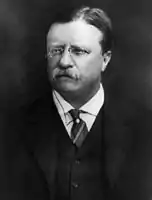 |
President of the United States (1901–1909) |
 New York |
(Positions) Defeated at convention: June 10, 1916 |
80,019 (4.2%) |
CO, ID, NJ*, NC [data missing] | |
| Robert M. La Follette |  |
U.S. Senator from Wisconsin (1906–1925) |
 Wisconsin |
Defeated at convention: June 10, 1916 |
133,426 (6.9%) |
ND, WI [data missing] | |
| Albert B. Cummins | 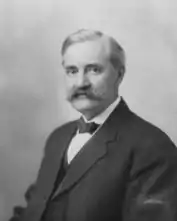 |
U.S. Senator from Iowa (1908–1926) |
 Iowa |
Defeated at convention: June 10, 1916 |
191,950 (10.0%) |
IA, MN, NM, ND, MT, SD [data missing] | |
| Theodore Burton |  |
U.S. Senator from Ohio (1909–1915) |
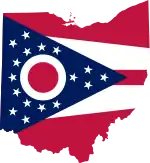 Ohio |
Defeated at convention: June 10, 1916 |
122,165 (6.4%) |
HI, OH, WV [data missing] | |
| Charles Fairbanks | 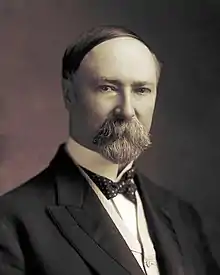 |
Vice President of the United States (1905–1909) |
 Indiana |
Defeated at convention: June 10, 1916 (nominated for Vice President) |
176,078 (9.2%) |
IN, KY [data missing] | |
Favorite sons
The following candidates entered only their home state's delegate selection contest for the purpose of controlling those delegates at the national convention:
- Governor Martin G. Brumbaugh of Pennsylvania
- Senator Lawrence Y. Sherman from Illinois
- Industrialist and peace activist Henry Ford of Michigan
Declined
- Senator William E. Borah of Idaho
- Governor Hiram Johnson of California (Progressive)
- Senator Henry Cabot Lodge of Massachusetts
- Former President William Howard Taft of Ohio
- Governor Charles S. Whitman of New York
Schedule and results
Tablemaker's Note:[lower-alpha 6]
| Date | Total pledged delegates |
Contest and total popular vote |
Delegates won and popular vote | |||||||||||||
|---|---|---|---|---|---|---|---|---|---|---|---|---|---|---|---|---|
| Other(s) Unpledged | ||||||||||||||||
| February 9 | 8 (of 8) | Florida convention[13] |
- | - | - | - | - | - | - | - | - | - | - | - | - | 8 |
| March 1 | 21 (of 21) | North Carolina convention[14] |
- | - | - | - | - | - | - | - | - | - | - | - | - | 21 |
| March 2 | 26 (of 26) | Kentucky convention[15] |
- | - | - | - | 26 | - | - | - | - | - | - | - | - | - |
| March 7 | 30 (of 30) | Indiana primary[16] 176,224 |
- | - | - | - | 30 176,224 (100.00%) |
- | - | - | - | - | - | - | - | - |
| 11 (of 11) | South Carolina convention[17] |
- | - | - | - | - | - | - | - | - | - | - | - | - | 11 | |
| March 14 | 24 (of 24) | Minnesota primary[18] 70,617 |
- | 24 54,214 (76.77%) |
- | - | - | - | - | - | - | - | - | - | - | 16,403[lower-alpha 7] (23.22%) |
| 8 (of 8) | New Hampshire primary[19] 10,838 |
- | - | - | - | - | 2,988 (27.57%) | - | - | - | - | - | - | - | 8 7,850 (72.43%) | |
| March 21 | 10 (of 10) | North Dakota primary[20] 33,225 |
- | - | - | - | - | - | - | - | - | - | 10 23,374 (70.35%) |
- | - | 9,851[lower-alpha 8] (29.65%) |
| March 22 | 20 (of 20) | Kansas convention[21] |
- | - | - | - | - | - | - | - | - | - | - | - | - | 20 |
| March 23 | 12 (of 12) | Maine convention[22] |
- | - | - | - | - | - | - | - | - | - | - | - | - | 12 |
| 20 (of 20) | Oklahoma convention[23] |
- | - | - | - | - | - | - | - | - | - | - | - | - | 20 | |
| March 29 | 12 (of 12) | Louisiana convention[24] |
- | - | - | - | - | - | - | - | - | - | - | - | - | 12 |
| March 30 | 15 (of 15) | Virginia convention[25] |
- | - | - | - | - | - | - | - | - | - | - | - | - | 15 |
| April 3 | 30 (of 30) | Michigan primary[26] 176,671 |
303 WI (0.17%) | - | - | - | - | 1,074 WI (0.61%) | - | - | - | 30 83,057 (47.01%) |
- | - | - | 92,327[lower-alpha 9] (52.26%) |
| April 4 | 87 (of 87) | New York primary ? |
- | - | - | - | - | - | - | - | - | - | - | - | - | 87 ?[lower-alpha 10] (?%) |
| 0 (of 26) | Wisconsin Pres. primary 111,399 |
- | - | - | - | - | - | - | - | - | - | 110,052 (98.79%) | - | - | 1,347 (1.21%) | |
| 26 (of 26) | Wisconsin primary[27] ? |
- | - | - | - | - | - | - | - | - | - | 15 69,284 (?%) |
- | - | 11 71,188[lower-alpha 11] (?%) | |
| April 7 | 36 (of 36) | Missouri convention[28] |
- | - | - | - | - | - | - | - | - | - | - | - | - | 36 |
| April 10 | 26 (of 26) | Iowa primary[29] 44,288 |
1,270 WI (2.87%) | 26 40,157 (90.67%) |
513 WI (1.16%) | - | - | 2,348 WI (5.30%) | - | - | - | 1 WI (0.00%) | - | - | - | - |
| April 11 | 0 (of 58) | Illinois Pres. primary 176,671 |
1,078 WI (0.62%) | - | 447 WI (0.26%) | - | - | 15,348 WI (8.87%) | 155,945 (90.15%) | - | - | - | 49 WI (0.03%) | - | - | 86 WI[lower-alpha 12] (0.04%) |
| 58 (of 58) | Illinois primary[30] ?[lower-alpha 13] |
- | - | - | - | - | 2 110,728[lower-alpha 14] (?%) |
56 143,353 (?%) |
- | - | - | - | - | - | - | |
| April 12 | 6 (of 6) | Delaware convention[31] |
- | - | - | - | - | - | - | - | - | - | - | - | 6 | - |
| 17 (of 17) | Georgia convention[32] |
- | - | - | - | - | - | - | - | - | - | - | - | - | 17 | |
| April 13 | 14 (of 14) | Connecticut convention[33] |
- | - | - | - | - | - | - | - | - | - | - | - | - | 14 |
| April 17 | 10 (of 10) | Rhode Island convention[34] |
- | - | - | - | - | - | - | - | - | - | - | - | - | 10 |
| April 18 | 16 (of 16) | Nebraska primary[35][36] 88,607 |
15,837 WI (17.87%) | 14 29,850 (33.69%) |
- | - | - | 2,256 WI (2.55%) | - | - | - | 2 26,884 (30.34%) |
10 WI (0.01%) | - | - | 13,770 [lower-alpha 15] (15.54%) |
| April 19 | 2 (of 2) | Alaska Territorial Convention[37] |
- | - | - | - | - | - | - | - | - | - | - | - | - | 2 |
| April 21 | 8 (of 8) | Idaho convention[38] |
- | - | - | - | - | - | - | - | - | - | - | - | - | 8 |
| 8 (of 8) | Montana primary 14,194 |
564 WI (3.97%) | 8 10,415 (73.38%) |
- | - | - | 2,635 WI (18.56%) | - | - | - | 134 WI (0.94%) | 64 WI (0.45%) | - | - | 382 (2.69%) | |
| April 25 | 36 (of 36) | Massachusetts Pres. primary 108,969 |
- | - | - | - | - | 46,206 (42.40%) | - | - | - | - | - | - | - | 36 62,763[lower-alpha 16] (57.60%) |
| 0 (of 28) | New Jersey Pres. primary 1,764 |
393 WI (22.28%) | - | 74 WI (4.20%) | - | - | 1,084 WI (61.45%) | - | - | - | 86 WI (4.88%) | - | 5 WI (0.28%) | - | 122 WI[lower-alpha 17] (6.92%) | |
| 28 (of 28) | New Jersey primary[39][40] ? |
- | - | - | - | - | 2 ? (?%) |
- | - | - | - | - | - | - | 26 41,367[lower-alpha 18] (?%) | |
| 48 (of 48) | Ohio primary 140,682 |
469 WI (0.33%) | - | - | 48 122,165 (86.84%) |
- | 1,932 WI (1.37%) | - | - | - | 1,683 WI (1.20%) | - | - | - | 14,433 [lower-alpha 19] (10.26%) | |
| April 27 | 15 (of 15) | Arkansas convention[41] |
- | - | - | - | - | - | - | - | - | - | - | - | - | 15 |
| 6 (of 6) | New Mexico convention[42] |
- | - | - | - | - | - | - | - | - | - | - | - | - | 6 | |
| May 1 | 12 (of 12) | Mississippi convention[43] |
- | - | - | - | - | - | - | - | - | - | - | - | - | 12 |
| May 2 | 26 (of 26) | California primary[44] 229,349 |
- | - | - | - | - | - | - | - | - | - | - | - | - | 26 229,349[lower-alpha 20] (100.00%) |
| 8 (of 8) | Utah convention[45] |
- | - | - | - | - | - | - | - | - | - | - | - | - | 8 | |
| May 3 | 12 (of 12) | Colorado convention[46] |
- | - | - | - | - | - | - | - | - | - | - | - | - | 12 |
| May 4 | 21 (of 21) | Tennessee convention[47] |
- | - | - | - | - | - | - | - | - | - | - | - | - | 21 |
| May 5 | 16 (of 16) | West Virginia convention[48] |
- | - | - | - | - | - | - | - | - | - | - | - | - | 16 |
| May 6 | 6 (of 6) | Arizona convention[49] |
- | - | - | - | - | - | - | - | - | - | - | - | - | 6 |
| 14 (of 14) | Washington convention[50] |
- | - | - | - | - | - | - | - | - | - | - | - | - | 14 | |
| May 8 | 6 (of 6) | Wyoming convention[51] |
- | - | - | - | - | - | - | - | - | - | - | - | - | 6 |
| May 9 | 16 (of 16) | Maryland convention[52] |
- | - | - | - | - | - | - | - | - | - | - | - | - | 16 |
| May 16 | 0 (of 72) | Pennsylvania Pres. primary 270,195 |
1,804 WI (0.67%) | - | - | - | - | 12,359 WI (4.57%) | - | - | 382 WI (0.14%) | 20,255 WI (7.50%) | - | 233,095 (86.27%) | - | 1,526 WI[lower-alpha 21] (1.57%) |
| 72 (of 72) | Pennsylvania primary[53] ? |
- | - | - | - | - | - | - | - | - | - | - | 17 [lower-alpha 22] 208,325 (?%) |
- | 55 251,514 (?%) | |
| 0 (of 8) | Vermont primary[54] 7,834 |
5,480 WI (69.95%) | - | 180 WI (2.30%) | - | - | 1,931 WI (24.65%) | - | 28 WI (0.36%) | - | 34 WI (0.43%) | - | - | - | 181 WI[lower-alpha 23] (2.31%) | |
| May 19 | 10 (of 10) | Oregon primary 94,915 |
10 56,764 (59.81%) |
27,558 (29.03%) | - | 10,593 (11.16%) | - | - | - | - | - | - | - | - | - | - |
| May 20 | 16 (of 16) | Mississippi convention[55] |
- | - | - | - | - | - | - | - | - | - | - | - | - | 16 |
| May 23 | 10 (of 10) | South Dakota primary[56] 29,656 |
- | 10 29,656 (100.00%) |
- | - | - | - | - | - | - | - | - | - | - | - |
| May 24 | 26 (of 26) | Texas convention[57] |
- | - | - | - | - | - | - | - | - | - | - | - | - | 26 |
| May 26 | 8 (of 8) | Vermont convention[58] |
8 | - | - | - | - | - | - | - | - | - | - | - | - | - |
| June 6 | 0 (of 16) | West Virginia Pres. primary[59] 18,685[lower-alpha 24] |
- | - | - | 15,823 (84.68%) | - | - | - | - | - | - | - | - | - | 2,862[lower-alpha 25] (15.32%) |
| Total 983 pledged delegates 1,704,783 votes |
18 78,482 (4.60%) |
82 191,850 (11.25%) |
0 1,214 (0.07%) |
48 148,581 (8.72%) |
56 176,224 (10.34%) |
4 90,161 (5.29%) |
56 155,945 (9.15%) |
0 28 (0.00%) |
0 382 (0.02%) |
32 132,134 (7.75%) |
25 133,549 (7.83%) |
17 233,100 (13.67%) |
6 - (0.00%) |
629 390,489 (22.91%) | ||
| Suspected Delegate Count Eve of Convention[60] |
224 (22.70%) |
89 (9.02%) |
82 (8.31%) |
70 (7.09%) |
65 (6.56%) |
60 (6.08%) |
56 (5.67%) |
54 (5.47%) |
40 (4.05%) |
38 (3.85%) |
36 (3.65%) |
19 (1.93%) |
6 (0.61%) |
144 (1.42%) | ||
Campaign
Delegate selections began as early as March.
Early in the campaign, Theodore Roosevelt attempted to dampen widespread hopes that he would accept a joint Republican and Progressive nomination. On March 9, he issued a statement to the press insisting that his name "not be brought into the Massachusetts primaries" and "emphatically" declining to be a candidate. However, he declined to issue a Shermanesque statement and declared that his nomination would be a mistake "unless the country had in its mood something of the heroic."[61] The New York Times reported the statement under the headline "ROOSEVELT'S HAT AGAIN IN THE RING."[61]
While Roosevelt's support came largely from outside the Republican Party establishment, party loyalists attempted to recruit a candidate who would be acceptable to Progressives, or at least pacify Roosevelt. Their first choice was Charles Evans Hughes. Hughes, as Associate Justice of the Supreme Court, had the virtue of making few statements on political issues; even as an active politician, he had a character for reticence. He also had a reputation for progressivism as Governor of New York.[61] When Roosevelt returned from the Caribbean in late March, he found two presidential booms underway: one for himself and one for Hughes. Roosevelt privately feared Hughes would merely be "Wilson with whiskers."[61] However, Hughes was adamant that he was not a candidate; he had refused consideration in 1912 and had even stopped voting since joining the Court. "It seems to me very clear that, as a member of the Supreme Court, I have no right to be a candidate, either actively or passively," he wrote to New Jersey governor Edward C. Stokes.[62]
"I am torn between two profound desires: one to keep the judicial ermine unsullied and the other not to fail in meeting what might be a duty to the country."[62]
On March 31, Roosevelt made his first overt move toward a return to the Republican Party by lunching with Elihu Root, who as president of the 1912 Republican National Convention had been the focus of Roosevelt's tirades for four years.[63] With Wilson apparently vulnerable once more following Pancho Villa's attack on United States soil, Roosevelt appeared to be holding himself out for the nomination. However, Root himself had presidential ambitions as well.[63]
Despite his denials, supporters entered Hughes's name in the April Nebraska primary. Hughes responded by threatening legal action to keep his name off the state ballot; nevertheless, the media and party supporters continued to trumpet Hughes as a candidate.[62] He was finally persuaded by a letter from former President Taft, who argued that Hughes was the only man who could united the Progressives and Republicans and defeat Wilson. Taft wrote, "Your opportunity as President to guide the country through the trial bound to come after the war will be as great as Washington's or Lincoln's. You are equal to it. Strong men will respond to your call because you are yourself so satisfying in strength and in your political courage and patriotism."[62] Sufficiently flattered, Hughes consulted with his colleagues Willis Van Devanter and Edward Douglass White; both urged him to accept if nominated.[62]
Meanwhile, Roosevelt campaign committees and headquarters were soon established across the country. Roosevelt himself confided to Hiram Johnson that his true ambition was to "get the Republicans and Progressive together for someone whom we can elect and whom it will be worth electing." Privately, he believed that was Hughes, but held on to the ambition that he would be drafted by the delegates.[63] Roosevelt's support faded after President Wilson took a stronger rhetorical stance against Germany.[64]
May: Hughes in front
As the convention approached, Hughes began to receive intimations from Chief Justice White and Interior Secretary Franklin Lane that Wilson planned to appoint him as Chief Justice on White's retirement. Hughes responded that he would not allow the offer to affect his decision; he may have resolved to accept the nomination rather than be implicated in an apparent quid pro quo with Wilson.[62] As the campaign came to a close, Hughes polled as the first choice of many Republican voters. He won the May primaries in Vermont (over Roosevelt) and Oregon (over Cummins) by wide margins.[62] Frank Harris Hitchcock and Eugene Meyer, who managed the Hughes boom, found little trouble winning commitments from independent delegates to vote for Hughes.[62]
Pre-convention maneuvering
On June 8, as the Republican and Progressive parties each convened in Chicago, leaders of the two met privately to discuss a compromise candidate. The Progressives made clear that the only acceptable name was Roosevelt; Republicans balked and resolved to risk a split by nominating Hughes or a more conservative man.
See also
Notes
- ↑ As recorded on the opening ballot.
- ↑ As recorded on the opening ballot.
- ↑ As recorded on the opening ballot.
- 1 2 California, Massachusetts, New Hampshire, and New York elected uncommitted slates of electors. Favorite sons won the popular vote in Michigan (Henry Ford), Illinois Lawrence Yates Sherman, and Pennsylvania (Martin Brumbaugh).
- 1 2 Favorite sons won the support of Michigan (Henry Ford), Illinois Lawrence Yates Sherman, and Pennsylvania (Martin Brumbaugh). Former President William Howard Taft carried the state of Texas.
- ↑ This should not be taken as a finalized list of results. While a significant amount of research was done, there were a number of States which also elected Delegates at the Congressional level who were not always bound by the instructions of the convention, and these are not yet reflected in the table. Many states also held primaries for the delegate positions, and these on occasion were where slates or candidates pledge to a certain candidate might be elected; however, as these elections allowed for a single person to vote for multiple candidates, as many as the number of positions being filled, it is difficult to determine how many people actually voted in these primaries. For this reason, while the results of some are in the table, except in those rare cases where a total vote is provided, they are not included in the popular vote summaries at the bottom of the table.
- ↑ Includes 12,693 votes for Henry Estabrook at (17.97%), and 3,710 votes for William Grant Webster at (5.25%).
- ↑ All votes attributed to Henry Estabrook.
- ↑ Includes 77,872 votes for Senator William Alden Smith at (44.08%), and 14,365 votes for William Simpson at (8.13%).
- ↑ There was only a single list of candidates, named by the State Republican Party. The vote count does not seem to have been reported in detail.
- ↑ While Governor Emanuel Philipp came first among those running as at-large delegates, his fellow "Regular" Republicans did not do as well against the "La Follette" Republicans; the latter carried the remaining three at-large delegate spots, and carried the majority of the district delegates.
- ↑ Includes 50 votes for former President Howard Taft, 20 votes for John Maynard Harlan, and 16 votes for Congressmen James Robert Mann.
- ↑ Returns are incomplete; the official canvass published in May did not include Harlan's vote.
- ↑ Represents John Maynard Harlan, who was running as a Pro-Roosevelt delegate.
- ↑ Includes 8,132 votes for Henry Estabrook at (9.18%), and 5,506 votes for Robert G. Ross at (6.21%).
- ↑ Representing a slate of unpledged delegates.
- ↑ Includes 47 Write-In votes for Woodrow Wilson at (2.66%), 31 Write-In votes for William Howard Taft at (1.76%), and 10 Write-In votes for Senator William Hughes at (0.57%).
- ↑ There was only a single list of candidates, named by the State Republican Party. The vote count does not seem to have been reported in detail.
- ↑ Includes 14,217 votes for William Grant Webster at (10.11%), and 211 Write-In votes for Warren G. Harding at (0.15%).
- ↑ There were two uncommitted slates running in the primary; one, the 'Regulars', opposed any alliance with the California Progressives, while the other, the 'United-Republicans', desired an alliance with the Progressive Party and was actively supported by Hiram Johnson. The 'Regular' Republican slate won 132,836 votes, whereas the 'United-Republican' slate won 96,513 votes.
- ↑ Includes 774 Write-In votes for Joseph R. Grundy.
- ↑ Only seventeen of the elected delegates were pledged to support the primary winner.
- ↑ Represents Write-In Votes for Samuel McCall
- ↑ Partial Returns from 1,081 out of 1,730 precincts.
- ↑ All votes for William Grant Webster.
References
- ↑ Kalb, Deborah (2016-02-19). Guide to U.S. Elections - Google Books. ISBN 9781483380353. Retrieved 2016-02-19.
- ↑ Morris 2010, p. 392.
- ↑ Ross A. Kennedy, The Will to Believe: Woodrow Wilson, World War I, and America's Strategy for Peace and Security (Kent State University Press, 2009)
- ↑ Cuff, Robert D.; Urofsky, Melvin I. (Autumn 1970). "The Steel Industry and Price-Fixing during World War I". The Business History Review. 3. 44 (3): 291–306. doi:10.2307/3112615. JSTOR 3112615. S2CID 156027992.
- ↑ Morris 2010, pp. 421–423.
- ↑ Morris 2010, p. 361.
- ↑ Morris 2010, p. 355.
- ↑ Morris 2010, p. 357.
- ↑ Morris 2010, p. 365.
- ↑ Morris 2010, p. 426.
- ↑ Morris 2010, pp. 394–401.
- ↑ Morris 2010, p. 446.
- ↑ "REPUBLICANS OF FLORIDA GO UNINSTRUCTED". The Pensacola Journal. Pensacola, Florida. Feb 10, 1916. Retrieved September 11, 2023.
- ↑ "MARION BUTLER TAKES CHARGE". The French Broad Hustler. Hendersonville, North Carolina. March 2, 1916. Retrieved September 11, 2023.
- ↑ "FAIRBANKS GETS KENTUCKY DELEGATION TO CHICAGO". The Lexington Leader. Lexington, Kentucky. March 2, 1916. Retrieved September 11, 2023.
- ↑ "NEW'S PLURALITY CLIMBS TO 7,868". The Minneapolis Morning Tribune. Indianapolis, Indiana. March 11, 1916. Retrieved September 6, 2023.
- ↑ "WILL NOT HAMPER THEIR DELEGATES". The State. Columbia, South Carolina. March 8, 1916. Retrieved September 11, 2023.
- ↑ "Cummins Wins Out in primary; Small Vote Is Cast". The Minneapolis Morning Tribune. Minneapolis. March 15, 1916. Retrieved March 7, 2022.
- ↑ "Total Vote of the Primaries". The Portsmouth Herald. Portsmouth. March 21, 1916. Retrieved March 7, 2022.
- ↑ "La Follette Gets North Dakota in Presidency Race". The Wisconsin State Journal. Madison. March 22, 1916. Retrieved March 7, 2022.
- ↑ "STANDPATTERS WIN THEIR FIGHT FOR DELEGATES". The Topeka State Journal. Topeka, Kansas. March 22, 1916. Retrieved September 11, 2023.
- ↑ "MAINE DELEAGTES GO UNINSTRUCTED BUT FAVOR HUGHES". The Bangor Daily News. Bangor, Maine. March 24, 1916. Retrieved September 9, 2023.
- ↑ "MCGRAW WINS A COMPLETE VICTORY AFTER HARD FIGHT". The Daily Oklahoman. Oklahoma City, Oklahoma. March 23, 1916. Retrieved September 11, 2023.
- ↑ "LILY WHITES AND BLACKS HAVE RUN IN". The Shreveport Times. Shreveport, Louisiana. March 29, 1916. Retrieved September 11, 2023.
- ↑ "ELECT DELEAGTES TO CONVENTION". The Alexandria Gazette. Alexandria, Virginia. March 30, 1916. Retrieved September 11, 2023.
- ↑ "Ford Majority Exceeds Five Thousand Over Smith". St. Joseph Evening Herald. St. Joseph. April 7, 1916. Retrieved March 7, 2022.
- ↑ "FINISHES COUNT OF primary ELECTION". The Wisconsin State Journal. Madison, Wisconsin. April 10, 1916. Retrieved September 7, 2023.
- ↑ "REPUBLICANS HOPE TO WIN STATE BY ATTACKING MAJOR". The St. Louis Dispatch. St. Louis, Missouri. April 7, 1916. Retrieved September 9, 2023.
- ↑ "FINISHES COUNT OF primary ELECTION". The Des Moines Register. Des Moines, Iowa. April 26, 1916. Retrieved September 7, 2023.
- ↑ "COMPLETE UNOFFICIAL STATE WIDE VOTE DELEGATES AT LARGE". The Chicago Tribune. Chicago, Illinois. April 7, 1916. Retrieved September 7, 2023.
- ↑ "BREACH IN RANKS OF REPUBLICANS WIDER THAN EVER". The News Journal. Wilmington, Delaware. April 12, 1916. Retrieved September 11, 2023.
- ↑ "G.O.P. CONVENTION NAMES DELEGATES". The Macon Telegraph. Macon, Georgia. May 20, 1916. Retrieved September 11, 2023.
- ↑ "REPUBLICANS PICK CHICAGO DELEGATES". The Hartford Courant. Hartford, Connecticut. April 13, 1916. Retrieved September 9, 2023.
- ↑ ""SUPPORT OF UNITED REPUBLICAN TICKET"". The Boston Globe. Boston, Massachusetts. April 17, 1916. Retrieved September 9, 2023.
- ↑ "RESULT OF primary". Nebraska State Journal. Lincoln, Nebraska. May 6, 1916. Retrieved September 7, 2023.
- ↑ "HUGHES IN LEAD WITH 224 VOTES". The New York Times. New York, New York. June 7, 1916. Retrieved September 7, 2023.
- ↑ "ALASKAN DELEGATES TO CHICAGO UNINSTRUCTED". The Idaho Statesman. Boise, Idaho. April 20, 1916. Retrieved September 9, 2023.
- ↑ "BORAH HEADS IDAHO DELEGATION TO REPUBLICAN NATIONAL CONVENTION AT CHICAGO". The Evening Capital News. Boise, Idaho. April 21, 1916. Retrieved September 9, 2023.
- ↑ "OFFICIAL FIGURES OF PRIMARIES". Atlantic City Daily Press. Atlantic City, New Jersey. May 15, 1916. Retrieved September 7, 2023.
- ↑ "ROOSEVELT MEN FOR CONVENTION". Atlantic City Daily Press. Atlantic City, New Jersey. April 29, 1916. Retrieved September 7, 2023.
- ↑ ""LILIES" CONTROL G.O.P. CONVENTION". The Arkansas Gazette. Little Rock, Arkansas. April 27, 1916. Retrieved September 11, 2023.
- ↑ "G.O.P. GIVES LOUD CHEERS FOR T.R. AT CONVENTION". The Santa Fe New Mexican. Santa Fe, New Mexico. April 26, 1916. Retrieved September 11, 2023.
- ↑ "REPUBLICANS WILL GO TO CONVENTION UNINSTRUCTED". The Hattiesburg News. Hattiesburg, Mississippi. March 2, 1916. Retrieved September 11, 2023.
- ↑ "OFFICIAL COUNT OF THE primary". The Los Angeles Times. Los Angeles, California. May 26, 1916. Retrieved September 7, 2023.
- ↑ "DEMOCRATS ARE DENOUNCED AT BIG GATHERING". The Salt Lake Tribune. Salt Lake City, Utah. May 2, 1916. Retrieved September 11, 2023.
- ↑ "REPUBLICAN convention". The Gilpin Observer. Central City, Colorado. May 4, 1916. Retrieved September 11, 2023.
- ↑ "HARMONY PREVAILS IN REPUBLICAN CONVENTION". The Nashville Tennessean. Nashville, Tennessee. May 4, 1916. Retrieved September 11, 2023.
- ↑ "WEST VA'S BIG FOUR TO CHICAGO NATIONAL CONVENTION SELECTED AT ENTHUSIASTIC convention YESTERDAY". The Wheeling Intelligencer. Wheeling, Virginia. May 5, 1916. Retrieved September 11, 2023.
- ↑ "REGULAR, OLD LINERS CHOSEN FOR DELEGATES". The Arizona Republican. Phoenix, Arizona. May 7, 1916. Retrieved September 11, 2023.
- ↑ "STATE G.O.P. DELEGATION GOES TO CHICAGO UNPLEDGED". The Spokesman-Review. Spokane, Washington. May 7, 1916. Retrieved September 9, 2023.
- ↑ "STATE G.O.P. DELEGATION GOES TO CHICAGO UNPLEDGED". The Natrona County Tribune. Casper, Wyoming. May 11, 1916. Retrieved September 11, 2023.
- ↑ "JACKSON-STONE MEN RUN G.O.P. CONVENTION". The Sun. Baltimore, Maryland. May 10, 1916. Retrieved September 11, 2023.
- ↑ "COMPARATIVE STANDING OF REPUBLICAN DELEGATES". The Harrisburg Daily Independent. Harrisburg, Pennsylvania. May 23, 1916. Retrieved September 8, 2023.
- ↑ "HUGHES 5,480, WEEKS 28". The Burlington Free Press. Burlington, Vermont. May 23, 1916. Retrieved September 9, 2023.
- ↑ "NO NEGROES IN G.O.P. ALABAMA DELEGATION". The Decatur Daily. New Decatur, Alabama. May 20, 1916. Retrieved September 11, 2023.
- ↑ "CUMMINS FIRST CHOICE". The Madison Daily Leader. Madison, South Dakota. May 26, 1916. Retrieved September 9, 2023.
- ↑ "TEXAS REPUBLICANS CHEER ROOSEVELT". The El Paso Herald. El Paso, Texas. March 24, 1916. Retrieved September 9, 2023.
- ↑ "ENTHUSIATIC VERMONT REPUBLICANS PROCLAIM IN RINGING RESOLUTIONS UNANSWERING LOYLATY TO HUGHES". The Burlington Free Press. Burlington, Vermont. May 23, 1916. Retrieved September 9, 2023.
- ↑ "SUTHERLAND LEADS IN SENATORIAL RACE". The Hinton Daily News. Hinton, West Virginia. June 9, 1916. Retrieved September 10, 2023.
- ↑ https://timesmachine.nytimes.com/timesmachine/1916/06/07/100209467.pdf?pdf_redirect=true&ip=0
- 1 2 3 4 Morris 2010, pp. 449–51.
- 1 2 3 4 5 6 7 8 Simon 2012, pp. 95–98.
- 1 2 3 Morris 2010, pp. 452–53.
- ↑ Morris 2010, p. 456.
Bibliography
- Morris, Edmund (2010). Colonel Roosevelt. New York: Random House.
- Simon, James F. (2012). FDR and Chief Justice Hughes: the President, the Supreme Court, and the Epic Battle Over the New Deal. New York: Simon & Schuster.
.jpg.webp)
